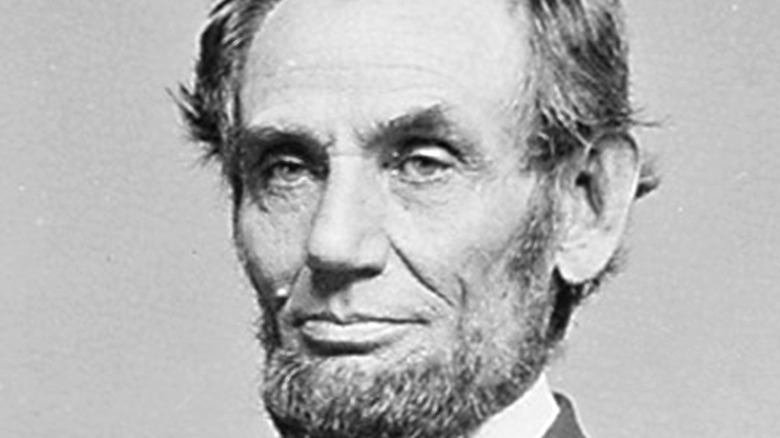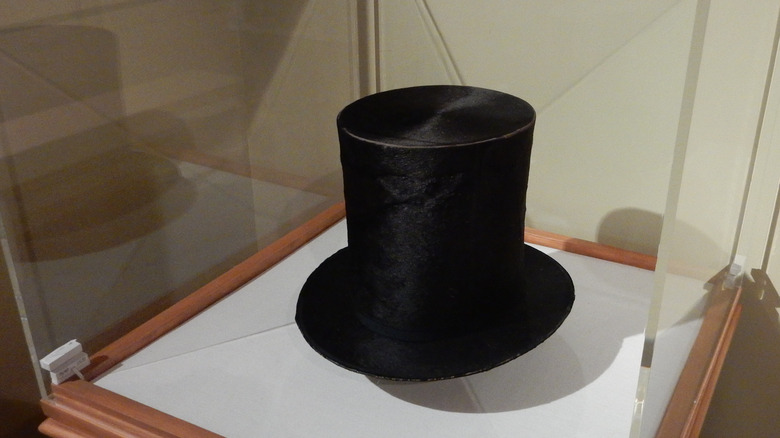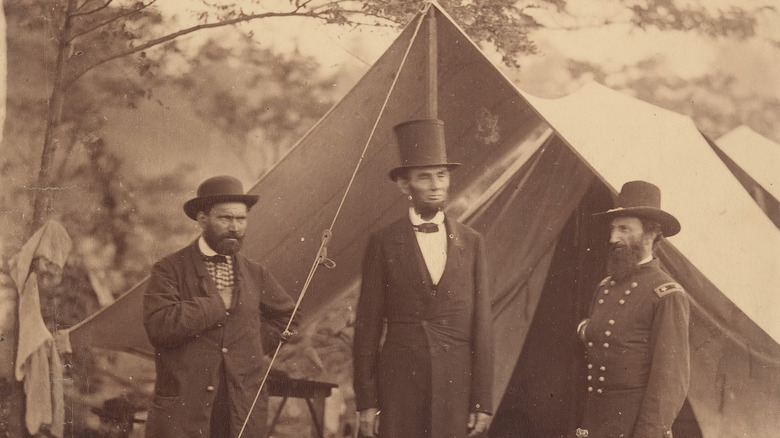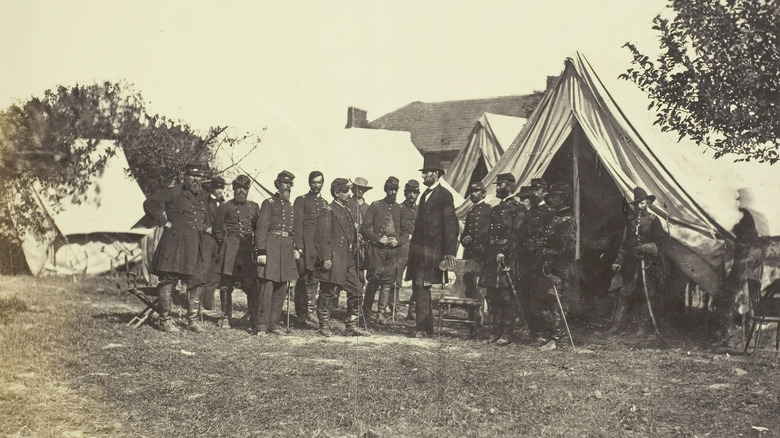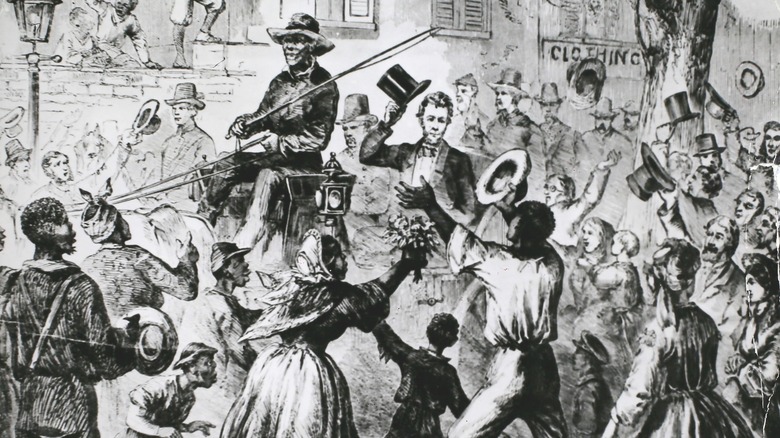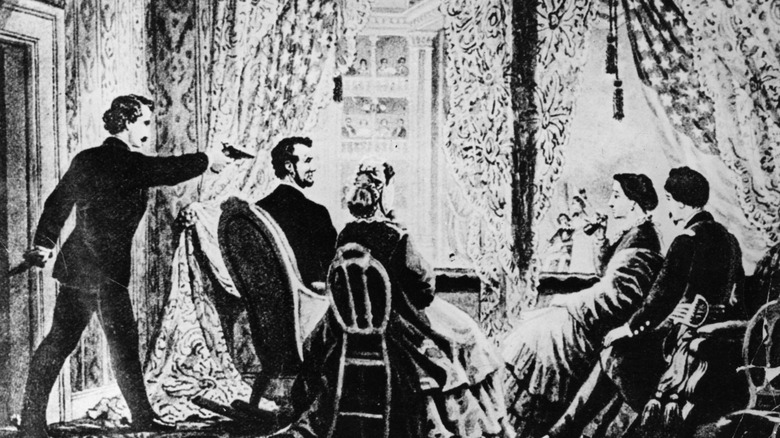What We Know About Abraham Lincoln's Famous Top Hat
When you think of our 16th president, Abraham Lincoln, probably more than a few things come to mind. You might think of the Civil War, the Emancipation Proclamation, or his famous Gettysburg Address. But when you picture him speaking to the crowd, the man in your mind's eye is probably tall, dark, and wearing his iconic stovepipe hat. The president was rarely seen out in public without a tall hat covering his dome. And while stovepipes were a fairly common clothing item for men at the time, over the years, this hat has become pretty synonymous with President Lincoln.
Lincoln's tall stovepipe stood out even more than usual because the president himself was such a tall man. Standing at six feet, four inches, he towered over most men and women of the day. Add in a hat that added seven or eight extra inches to his already impressive frame, and he was pretty much impossible to miss in a crowd, according to the Smithsonian Magazine. Although historians cannot pinpoint exactly when he began accessorizing with hats, Lincoln began wearing the stovepipe well before his presidency, donning it during debates, stump speeches, and even during his famous 1860 speech at the Cooper Institute in New York. He continued to wear his tall hat throughout his presidential term, sporting it everywhere, from speeches to battlefields, until the day of his death in 1865.
A stovepipe hat and a top hat have some key differences
Lincoln's signature hat is often referred to as a top hat. And while that is technically correct, it is perhaps more accurate to say that Lincoln most commonly wore a stovepipe hat. A stovepipe is technically a variation of a top hat, with both being tall, dark, flat-crowned hats. However, while to an untrained eye, a top hat and a stovepipe might initially look quite similar, there are a few key differences.
Perhaps the most important difference is their level of formality. Stovepipes are considered an informal subcategory of top hats, and tend to be made with non-fur felt or other less expensive materials, according to Hat Realm. They take their name from their distinctive shape, which is said to resemble a chimney or stovepipe. Top hats, on the other hand, are typically made with expensive materials like silk, real beaver skin fur, and black oilcloth coating. They are worn on formal occasions and tend to be much pricier than the more affordable stovepipe. While Lincoln certainly wore both throughout his presidency, donning top hats for fancy events and special occasions, Honest Abe's preferred everyday wear was a more common stovepipe hat.
Lincoln's hat may have been a publicity gimmick
Although no one can say for sure what made President Lincoln select this particular hat as his signature accessory, some historians believe it may have in part been a gimmick to make him more noticeable and recognizable to the public. Lincoln was also apparently so fond of his tall hats that he hung on to them until they were well-worn. Many reports described his hat as frequently looking beaten or disheveled. The reformer Carl Schurz, with whom Lincoln met in the 1850s, later recalled Lincoln's crumpled-looking hat and otherwise somewhat disheveled appearance at their first meeting, while other eyewitness accounts also describe a rather battered stovepipe, according to Smithsonian Magazine. It is quite possible that this was all part of the gimmick, meant to make him look more like a rugged frontiersman — a common man of the people.
However, Lincoln did purchase a new hat on at least one special occasion: his first presidential inauguration in 1860. On that day, the president-elect donned a new, stylish, shorter silk plush hat, However, once his first presidential term began, Lincoln went back to wearing his old, beloved stovepipe hat.
Lincoln's hat made him an easy target
Like most fashion statements, Lincoln's hat also enabled him to communicate without saying a word. The president reportedly kept important documents inside the band of his hat. It would also serve as a kind of prop when he wanted to make a point; he would remove it and even throw on the ground to express his temper when frustrated, according to Hat Realm. Removing the hat also served as a symbol of respect, one which Lincoln is said to have displayed when he removed his stovepipe in the presence of an African American man, a sign of respect not commonly shown to people of color at the time.
However, while Lincoln's tall hat may have given him many advantages, it also made him an easy target. Lincoln, standing close to seven feet tall with his hat on, could be easily picked out in a crowd, which could be dangerous for a wartime president. On more than one occasion, Lincoln was put at higher risk of being gunned down by angry would-be assassins, who had easy aim at their prominent target. While visiting the front lines at the Battle of Fort Stevens in July of 1864, union officers had to warn the president to get down from the battlements, fearing his tall frame and distinctive hat was too great of a target for Confederate shooters, according to Smithsonian Magazine. So this particular fashion accessory was certainly not without its dangers.
Lincoln's hat may have saved his life
However, while the stovepipe may have made the president an easy target, it is also rumored to have saved his life at least once. In the hot summer months, Lincoln would occasionally escape the Washington heat at a stone cottage he kept at the Soldiers' Home, about three miles northeast of the White House. In August of 1864, Lincoln was traveling alone by horseback back to the White House following one of his stays at the cottage when an unknown assailant shot at the president from behind the bushes (via Today I Found Out). The bullet missed the president, instead going clean through the crown of the hat, giving rise to the rumor that the stovepipe saved his life.
As he told the story, he was riding slowly, "immersed in deep thought" when he was startled by a rifle shot close by. He wasn't the only one startled; his horse "gave proof of decided dissatisfaction at the racket" and leaped forward, causing Lincoln to lose his hat in the process, "without any assent, express or implied, upon my part," as he described the event to his friend Ward Hill Lamon (via Abraham Lincoln's Assassination).
The last hat Lincoln wore is in the Smithsonian
While Lincoln was generally more partial to stovepipes than top hats, he did wear the latter on one very important day: the day that he was assassinated. On April 14, 1865, President Lincoln attended a comedy at the Ford Theatre with his wife, Mary Todd Lincoln. The president was wearing a suit and a silk top hat. The hat, made by the Washington hatmaker J.Y. Davis, measured 7 in x 10 3/8 in x 12 in and was adorned with a black mourning band in memory of his 11-year-old son Willie, who had recently passed away from typhoid fever, according to Abraham Lincoln Online. He sat in the presidential box, watching the performance of "Our American Cousin," when actor John Wilkes Booth slipped inside and shot him with a derringer pistol (via the Library of Congress). The president died as a result of his injuries nine hours later.
After his death, the War Department took possession of materials Lincoln had left at Ford Theater, including his hat, which was discovered on the floor next to his chair. Lincoln's widow allowed them to transfer possession of the hat to the Patent Office, which donated it to the Smithsonian Institution in 1867. However, it was prohibited from being exhibited, so it lived in the basement until 1893, when it was first displayed to the public by the Lincoln Memorial Association. The hat now resides in the Smithsonian's National Museum of American History.
